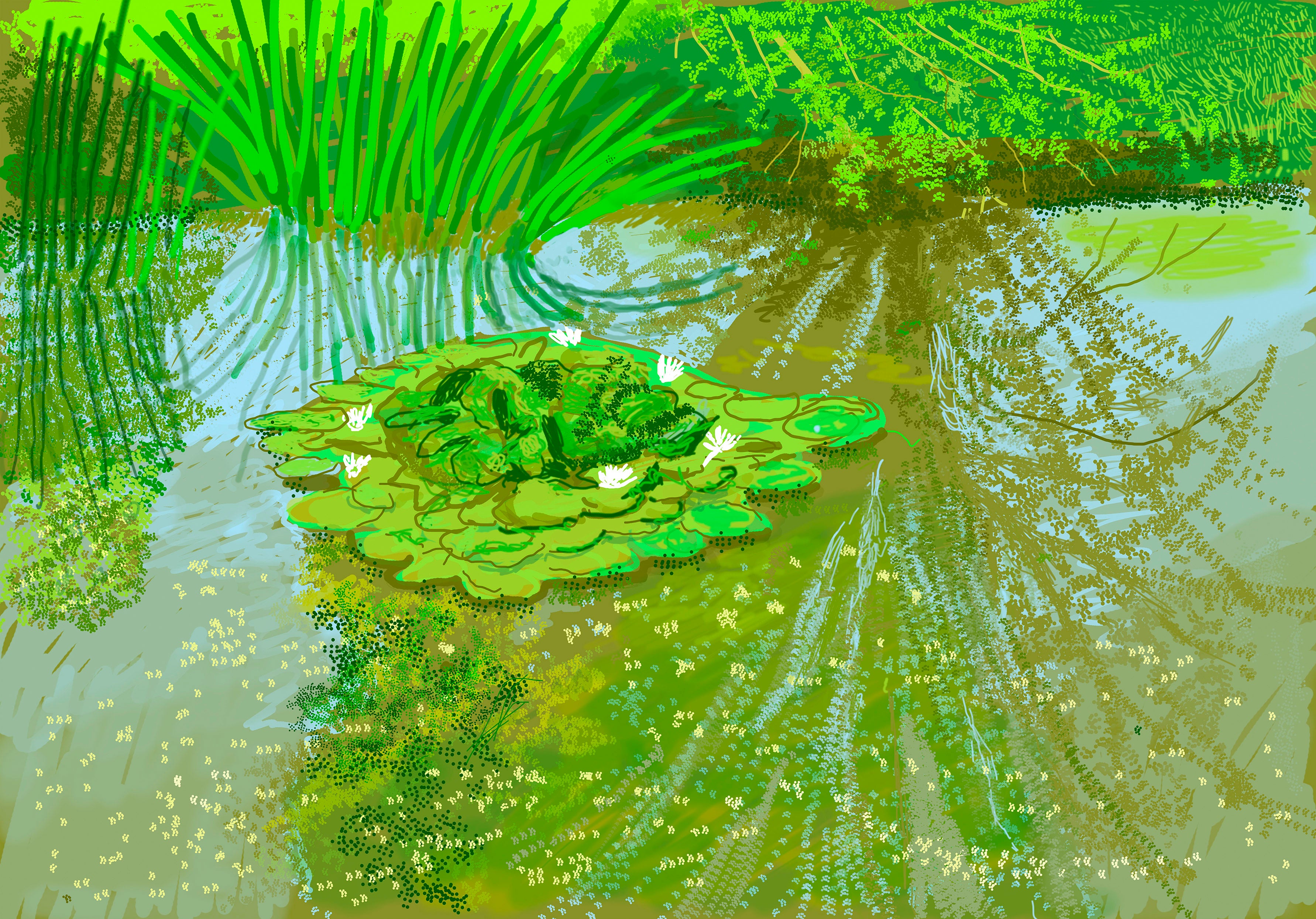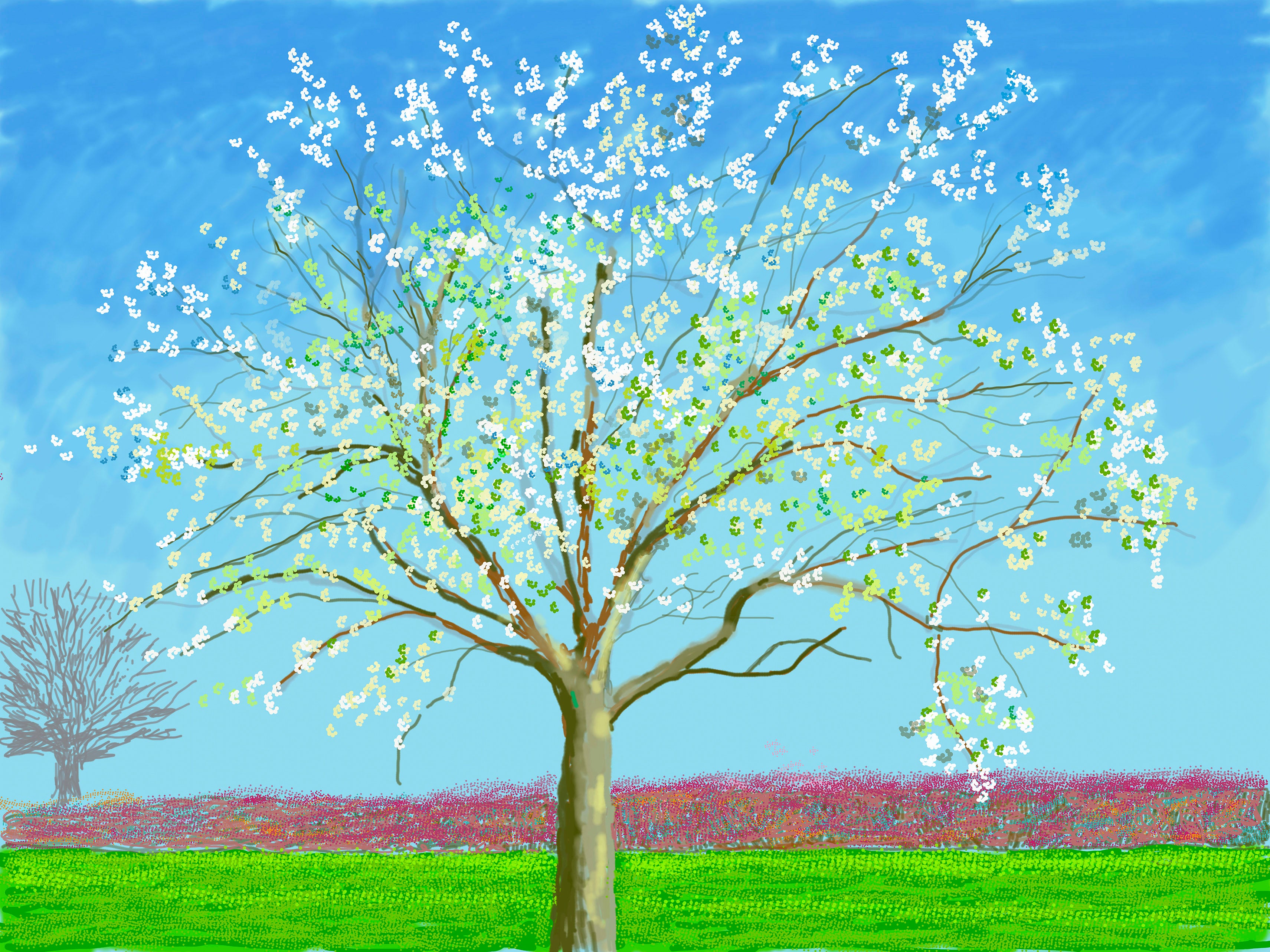Hockney or hackneyed... Has Britain’s greatest art rebel lost his edge?
The RA is showing David Hockney’s latest iPad landscapes that capture springtime unfolding. But the artist’s quirky charm and punchy pixels can’t mask its conformity, says Mark Hudson

Your support helps us to tell the story
From reproductive rights to climate change to Big Tech, The Independent is on the ground when the story is developing. Whether it's investigating the financials of Elon Musk's pro-Trump PAC or producing our latest documentary, 'The A Word', which shines a light on the American women fighting for reproductive rights, we know how important it is to parse out the facts from the messaging.
At such a critical moment in US history, we need reporters on the ground. Your donation allows us to keep sending journalists to speak to both sides of the story.
The Independent is trusted by Americans across the entire political spectrum. And unlike many other quality news outlets, we choose not to lock Americans out of our reporting and analysis with paywalls. We believe quality journalism should be available to everyone, paid for by those who can afford it.
Your support makes all the difference.It’s hard to give David Hockney an absolutely bad review. Taking a brutal swipe at this 83-year-old national treasure would feel like kicking an elderly relative. Hockney is one of the people who got us where we are today, part of that great levelling Sixties wave, on a par with The Beatles. With his droll Yorkshire charm – perfect for TV – and witty visual games-playing, Hockney gave modern art the common touch. But has the man who made contemporary art accessible to millions become a deeply conservative – and pretty dull – artist?
That is the near-inescapable impression on looking around the much-heralded exhibition of 116 iPad landscape paintings packing the walls of three of the Royal Academy’s grandest rooms in London.
Late in 2019, Hockney moved to rural Normandy ready to capture the arrival of spring, that timeless moment of unstoppable growth, when, as Hockney has pithily put it, “nature gets an erection”. It’s a subject Hockney first broached a decade ago in Yorkshire, in his first iPad works, returning to it in 2014 in a series of superb charcoal drawings. In these new pieces, he was well aware that the great impressionist Claude Monet witnessed this seasonal change 40 times at his home in nearby Giverny. And while these works weren’t conceived as a response to Monet, comparisons inevitably spring to mind. To put it mildly, they don’t work in Hockney’s favour.
The identically sized paintings confine themselves to the gardens and fields immediately surrounding Hockney’s house. While there’s nothing wrong with sticking close to home – plenty of artists have discerned the universal in stacks of washing up – there’s a painful mundanity to these images. Where there’s a tree, Hockney tends to plonk it square in the middle of the frame. Views of flower beds and topiaried bushes have a numbing ordinariness. A blankly unremarkable landscape with a low hill and a group of shrubs is put through what feels like endless iterations, which gain nothing from the occasional addition of sugary sunset effects; a clump of damp daffodils, meanwhile, hardly evokes nature at its most boisterously priapic.
While Hockney tells novelist Wiliam Boyd in the catalogue introduction that he was able to undertake these works because the “software could finally follow the hand”, you hardly believe that looking at these paintings. The delineation of trees is often clunkily stick-like or plain laboured. A whole series of paintings are filled with the branch-patterns of a large tree, gradually coming into blossom, but the sense of sinuous, springing growth, is utterly absent. Occasionally there’s a feeling of deliberate child-like faux-naivety to Hockney’s digital mark-making, which itself feels a bit of a cop out. On this showing, the iPad still doesn’t allow the linear wit and panache that has been one of Hockney’s strengths as an artist, and which, judging by the pen and ink drawings included in the catalogue, he still can pull off.
Colour is similarly limited by technology. The exhilarating, zinging green that bathes gardens and hedgerows in the first few days of spring is evoked here in an acidic, near-fluorescent hue. Looking around the galleries, its frigid synthetic glow is everywhere. While Hockney makes occasional nods to Monet and his hero Van Gogh in sparkling yellow, orange highlights and splashes of eye-popping red, the preponderance of this greenery and blue-grey skies feels ploddingly conventional, but with a touch of comfy English whimsy. I was often reminded of the fogeyish but enduringly popular mid-20th century illustrator Edward Bawden.
Yet if your first impression is that Hockney has lost it as a serious artist, there is, thankfully, slightly more to it than that. While these are called paintings, they’re actually print-outs. Images that appear richly layered from a distance dissolve into a flat, digitalised blur close-up. It’s when they’re at their most knowingly digital, however, that these paintings are most interesting.
Hockney has been playing with illusion and allusion since his student days. Here he references Seurat’s dot paintings, as he constructs form and foliage, not with hand-painted flecks a la Seurat, but clouds of identically circular digital spots; masses of identical lozenge-shaped leaves cover trees, while cloudy skies are matted in using digital “hatching” effects in lilac, blue and grey.

He seems less interested in nature per se than in exploring the possibilities and limitations of iPad technology, finding out how much or how little effort it’s necessary for him to make to evoke a particular effect on screen.
If a view of a tree (is it an apple?) beside a cornfield looks like a slightly amateurish Van Gogh pastiche, close-ups of the loose digital drawing-in of the fluorescent red highlights feel disconcertingly reminiscent of Andy Warhol. A study of irises, with the violet and yellow blooms seeming to sit flat on the picture surface, feels even more Warhol-like, while the abstracted patterns of rain on water in a number of works, reference Japanese woodblock prints, a classic eclectic Hockney touch that again harks back to his early career.
Yet the idea of Hockney coming to the landscape as a kind of latter-day pop artist, using it as a ready-made subject for technical and visual innovation, sits oddly with the patently and sometimes stultifyingly traditional character of most of the compositions. Synthesising different ways of depicting reality has been one of Hockney’s most interesting aspects as an artist, yet the different sides of this work don’t spark off each other except as manifestations of a quirky “charm” that’s allowed him to paper over a multitude of artistic sins over the decades.

You can’t help but respect Hockney’s energy in bringing this physically hefty body of work together. Some will be soothed by their comforting ordinariness, inspired even by the way Hockney, rather than raging against his declining powers, takes pleasure in small things – these are qualities that could yet make them iconic images of post-Brexit British culture, their “French” setting notwithstanding. Others will be exasperated by this cosiness and the apparent lack of ambition.
When Hockney the visual jester rears his head, toying with our expectations of landscape, the exhibition sparks into life. But when Hockney the phlegmatic modern impressionist dominates, there’s a painful tameness to the proceedings. As manifestations of “late style” to rival, say, Monet, these paintings don’t get near the launch pad.
‘David Hockney: The Arrival of Spring, Normandy, 2020’ at the Royal Academy of Arts, 23 May to 26 September



Join our commenting forum
Join thought-provoking conversations, follow other Independent readers and see their replies
Comments